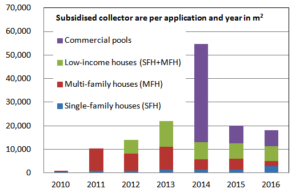USA: Big Market for big Systems
September 20, 2011
In October, German company PAW GmbH & Co. KG is going to introduce its big solar stations to the US market. Sales Manager Lars Bergmann has realised a trend towards big solar stations around the world, but more than anywhere in the US: turnover for the medium-size systems which PAW has already been selling in the States doubled last year – figures Jens-Peter Meyer was able to confirm in his market overview in Sun & Wind Energy 6/2011.
Bergmann sees in the boom of large solar systems in the US a result of the financial incentives granted by state and federal governments. Most of the incentive programmes have been in effect for a year or more, such as the CSI – Thermal Program in California. However, in case of ordering a solar thermal system for public institutions, such as schools and libraries, and for military facilities, the decision takes some time. Still, many construction projects have started this summer.
The new PAW solar station is sold to heating system suppliers who, in turn, sell it to their US customers. Every station can be equipped with collector fields of up to 150 m2 in Low Flow systems and as much as 4 stations can be combined to a cascade. The coupling of several systems to a cascade has the advantage of allowing standard components even in big systems, making them more economical. In addition, they provide a good fail-safe mechanism: if one station goes off-line, the remaining ones can still be used to prepare hot water.
Like the other PAW solar stations sold in the US, the new one has a so-called “visible leak detection”, which is required by many state laws. This means that there is not one but two plates between solar fluid and drinking water in the heat exchanger and between them is a fine air gap running towards the outside. If the heat exchanger is leaking, fluid will drop out of the solar station – thus, the name “visible” leak detection. The regulation was implemented by state authorities to make absolutely certain no glycol can enter the drinking water circuit.
An air gap in a heat exchanger may sound like a strange idea. But according to Bergmann, the new exchanger performs just as well as the conventional one because of its design adjustments. “We have performed simulations and taken measurements, and as it turns out, there is a surprisingly good exchange of heat,” Bergmann says.
Solar stations with plate heat exchangers are a trend of which not only PAW has taken notice. Meyer also mentions the trend towards large solar stations with plate heat exchangers and collector fields of 100 to 400 m2 in Sun & Wind Energy 6/2011. The cascade system as used by PAW is actually quite typical for fresh water stations and quite uncommon for big solar stations. Apart from PAW, only Taconova GmbH (which is also from Germany) uses some kind of a cascade system. Taconova does not combine several separate solar stations to one cascade, but integrates several pumps into one station, which can be operated as needed.
In case of medium-size solar systems of 30 to 50 m2, Meyer has observed many new conventional type solar stations. These solar stations do not possess an external plate heat exchanger, but have tubular ones inside the tank. In many US states, however, they would not prove feasible.
More information:
http://www.paw.eu
http://www.taconova.de
http://www.sunwindenergy.com


